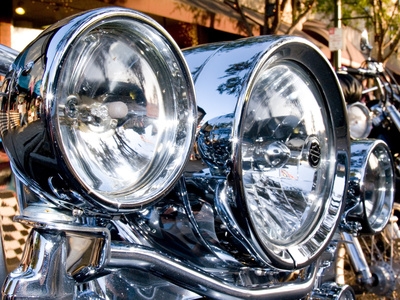
Chromium is one of the 91 naturally occurring chemical elements. Widely known as chrome, it is used as a decorative and protective metal applied in thin layers -- thousandths or millionths of an inch thick -- to a steel, brass, aluminum, copper, plastic or stainless steel base through the process of electroplating. The quality of decorative chrome used in automobiles and motorcycles is largely determined by tests which are run daily in large chrome plate shops to ensure rigorous standards are met.
Bright chromium plating is characterized by its bright metallic blue appearance. It is a hard, tarnish- and wear-resistant metal with one or more substrates of nickel or nickel and copper, depending on its intended application. For indoor products like office furniture and appliances, only one layer of nickel is required to provide optimum durability. For automobile and motorcycle trim, with its greater demand for corrosion resistance, a buffed copper layer is often applied to the bare steel, followed by at least two layers of nickel, one semi-bright and one bright. The bright nickel is anodic to the semi-bright nickel and protects it, thus spreading corrosion forces laterally and keeping it from penetrating to the steel base.
The CASS test -- Copper-Accelerated Acetic-Acid Salt Spray -- is the automotive industry's approved method for testing decorative electroplated chrome parts. It tests nickel/chromium and nickel/copper/chromium coatings for corrosion resistance. Copper chloride dihyrate is added to a solution of five parts salt to 95 parts water and atomized in a heated cabinet. The fog it creates is collected and the pH is adjusted to the required 3.1 to 3.3 by adding reagent grade glacial acetic acid. The chrome-plated part to be tested is cleaned with a solvent solution and placed inside the prepared cabinet for durations of between two and 96 hours. If the sample shows no cracks, blisters, chromium-loss or corrosion stains after 66 hours, it passes the test and is considered acceptable for OEM use.
The Fuhrman test is a relatively new quality control test for electroplated parts. It is based on the Dubpernell test which had been used for several years to determine microporosity. This method used the deposition of copper to indicate the number of active pores on the chromium. Only the exposed nickel is plated with copper and copper does not deposit on the chromium; this shows which areas have active pores that will potentially attract corrosion. When the CASS test was bumped up to nearly 100 hours of testing from the previously required 16 to 24 hours, the Dubpernell test lost its effectiveness since the pores indicated by it were not always active after such a lengthy exposure to the CASS test.
The Fuhrman method uses a prescribed voltage setting on individual surface areas; only those pores that have the capability to be active or create corrosion cells are indicated. This test more clearly and accurately indicates the actual active pores after the CASS test. The Fuhrman test is currently used by both Daimler-Chrysler and Volkswagen in their specifications.
Developed by Chrysler Corp., the STEP test measures the thickness and dissolution potential of the semi-bright and bright nickel layers used as substrate in a chrome-plated part. It is incorporated into most automotive specifications and considered a reliable indication of exceptional durability in severe conditions when used in conjunction with the Fuhrman and CASS tests.
The activity of the layers of nickel is controlled by electrolytes, therefore the proper maintenance and purity of the electrolytes contribute to optimal corrosion resistance. The STEP test measures these components in only a few minutes, but needs to be followed up with the Fuhrman test for microporosity and the CASS for a complete analysis of the corrosion resistance of the part.